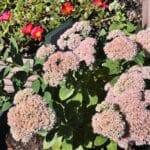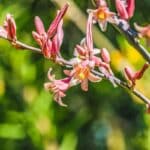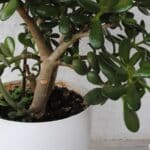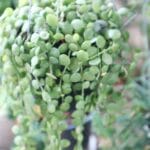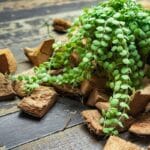Have you ever had a succulent that dies right after blooming? There is no reason to be sad and blame yourself. Your plant might be monocarpic. Read on to find out more about these types of succulents.
What Are Monocarpic Succulents?
For any succulent grower, a blooming plant is one of the most exciting things to see. The brightly colored flowers are sure to bring a smile to any face. But for a monocarpic succulent, this signals the end of their lives.
The term monocarpic came from the words mono and karpos which means ‘single’ and ‘fruit’ respectively. This means that the plant will produce flowers and fruit only once in its life, and then monocarpic succulents die (1).
Succulents are not the only kind of plants that are monocarpic, other plants like bamboos, palms, and bromeliads also fall in this category.
It may sound upsetting, but it is completely normal. It is your succulent’s way of safeguarding its progeny by directing all its resources towards producing seeds (2).
How Long Do Monocarpic Plants Live?
If you have a monocarpic succulent and worry about your plant’s longevity, you do not have to because these plant flowers can live for many years before they flower. Some monocarpic succulents, like Agave and Aeonium, can even live for a long time after flowering.
And, since most monocarpic succulent plants can also produce offsets and reproduce vegetatively, you can easily propagate your plant in between these years.
Can You Stop a Monocarpic Succulent from Dying?
It is uncertain whether you can stop a monocarpic succulent from dying. While some gardeners are able to, the success is still not guaranteed. Our best advice is to keep your succulent healthy to maximize its life cycle. Monocarpic succulents produce flowers early if they are stressed. You can also extend the life of your succulent by cutting off the flower stalk as soon as they appear.
Which Succulents Are Monocarpic?
Agave
Only some agave plants are monocarpic. Agaves, such as the century plant (Agave americana) can take up to 25 years to bloom. Even then, the succulent flowers can last for months, even years. The telling sign of an agave flowering is when it starts to develop a long, thick stem at the middle of its rosette. Clusters of colorful flowers will soon bloom from atop this stem (3).
Kalanchoe
Kalanchoe plants are another type of monocarpic plants. Unlike agave, kalanchoes can last only a few years before they flower and die. Fortunately, kalanchoes are a very prolific plant and can produce many offsets (4).
Sempervivum
All sempervivum plants are monocarpic. They generally last up to 3 years before blooming and dying. Like kalanchoe, sempervivums are very prolific growers and can produce many offsets in the 2 years before the plants bloom (4).
Agave, kalanchoe, and sempervivum are only the three most common types of monocarpic succulents. There are other monocarpic succulents such as Aeonium, Sinocrassula, Orostachys, and Peperomia.
How to Care for Monocarpic Succulents
Unlike their polycarpic counterparts, Monocarpic succulents bloom only once in their lifetime, putting on a spectacular floral display before gracefully bowing out. While their lifespan may seem limited, the journey to witness their bloom is a rewarding experience for any succulent enthusiast. Here’s how to provide the best care for these unique succulents:
Soil
Plant monocarpic succulents in well-draining soil to prevent waterlogging and root rot. Use a cactus or succulent potting mix or create your own by mixing equal parts of potting soil, perlite, and coarse sand. Ensure the soil is airy and loose to promote healthy root growth.
Water
Water monocarpic succulents sparingly, allowing the soil to dry out completely between waterings. During the growing season (spring and summer), water them when the top inch of soil feels dry to the touch. Reduce watering frequency in fall and winter when growth slows down. Avoid overwatering, as this can lead to root rot, particularly as the plant approaches maturity.
Fertilizer
Most monocarpic succulents generally don’t require frequent fertilization. A diluted, balanced fertilizer specifically formulated for cacti and succulents, applied at quarter strength once or twice during the growing season, is sufficient. Avoid fertilizing during the blooming period and completely stop during dormancy.
Propagate
Before flowering, monocarpic succulents often produce offsets or pups, at the base of the plant. These offsets can be carefully removed and planted separately to propagate new plants. Allow the offsets to callous for a few days before planting them in well-draining soil. Keep the soil lightly moist until roots develop, then treat the offsets as a mother plant.
Sunlight
These flowering succulents thrive in bright, indirect sunlight. Place them near a window where they can receive plenty of natural light, but protect them from direct sunlight, especially during the hottest part of the day. In regions with intense sunlight, provide partial shade to prevent leaf burn.
Pruning and Maintenance
During the flowering stage, monocarpic succulents divert all their energy into producing flowers and seeds. As a result, this succulent plant may appear less vibrant and may drop some lower leaves. Remove any dead or yellowing leaves to maintain the plant’s appearance, but avoid heavy pruning, as the plant is nearing the end of its life cycle.
FAQs
Should I remove dead parts of succulent?
Yes, it’s a good idea to remove dead parts of a succulent to maintain its overall health and appearance. Trimming away dead or damaged leaves, stems, or flowers can prevent the spread of disease and encourage new growth.
Is haworthia a monocarpic?
No, Haworthia plants are not monocarpic either. They are polycarpic succulents, meaning they can produce flowers and bloom multiple times over their lifespan.
Can you save a succulent death bloom?
If a succulent experiences a death bloom, it’s unlikely that the plant itself can be saved, as monocarpic species typically die after flowering. However, you can save any offsets (also known as pups or babies) produced by the parent plant before it dies. These offsets can be propagated to grow new plants and continue the succulent’s legacy.
If you love growing succulents, check these types of succulents with pictures.
References
Reference List:
(1) Cresson C. ‘Charles Cresson on the American Flower Garden’. Prentice Hall. 1993. PP. 41.
(2) Leshem Y.Y., Halevy A.H., Frenkel C. ‘Processes and Control of Plant Senescence’. Elsevier. 2012. PP. 120.
(3) Gentry H.S. ‘Agaves of Continental North America’. University of Arizona Press. 2004. PP. 30.
(4) Afra A. ‘The Succulent Manual: A guide to care and repair for all climates’. Andrea Afra. 2018.
Close
*image by photo_story/depositphotos


